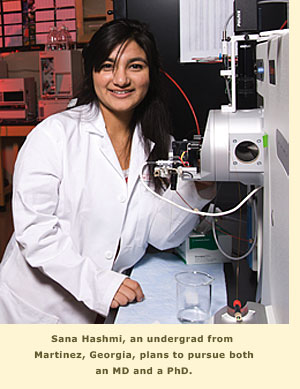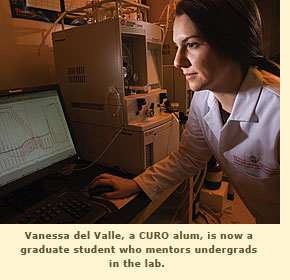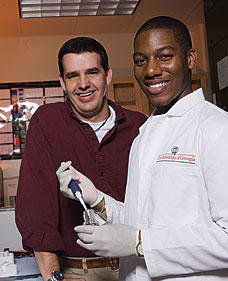Inquiring Young Minds

A unit of the UGA Honors Program gives undergraduates some genuine research opportunities—and helps them shine.
Sana Hashmi’s parents didn’t blink when their young daughter, a big fan of Bill Nye the Science Guy from the age of seven, asked them for science equipment. “Every birthday I would ask for a chemistry set or microscope,” she recalls. Her parents, neither of whom were scientists, complied by giving her the best microscopes and chemistry sets the local toy store had to offer.
 These days the Martinez, Georgia, native uses the real thing—thanks to the Center for Undergraduate Research Opportunities (CURO), a unit of the University of Georgia Honors Program—and she produces real results. Hashmi, now a UGA junior with a triple major in biology, microbiology and religion, along with graduate student Stephanie Hammond, investigates the structure of a protein whose absence has been linked to the spread of cancer.
These days the Martinez, Georgia, native uses the real thing—thanks to the Center for Undergraduate Research Opportunities (CURO), a unit of the University of Georgia Honors Program—and she produces real results. Hashmi, now a UGA junior with a triple major in biology, microbiology and religion, along with graduate student Stephanie Hammond, investigates the structure of a protein whose absence has been linked to the spread of cancer.
“The protein alpha-dystroglycan, or alpha-DG, anchors cells in the body through its sugar structures,” explains Hashmi, who works in the lab of Lance Wells at the Complex Carbohydrate Research Center (CCRC). “If these structures are deficient or absent in the presence of cancer cells, the cancer can spread to other parts of the body.” Hashmi and Hammond became the first in the world to identify and map these sugar structures, thereby bringing scientists one step closer to designing synthetic versions of alpha-DG that could help patients deficient in this protein fight cancer.
Hashmi won an award at a national student conference for best oral presentation when she described her work there, and she has presented her findings at an international scientific symposium as well. Publication of her research in the prestigious journal Nature Chemical Biology is under review.
Hashmi’s experience is one of many success stories for CURO, which offers students a variety of ways to engage in research. One way is the Apprentice Program, through which Hashmi began her own research, which accepts about a dozen promising freshmen each fall. “This is not cleaning test tubes,” she says. “The CURO apprenticeship actually lets me participate at the forefront of science, where professors are not just teachers but more like peer mentors. It’s really exciting.”
Marcus Hines, a freshman from Albany, Georgia, agrees. The latest addition to Wells’ lab, he is researching pancreatic cancer under Wells and Michael Tiemeyer, both professors of biochemistry and molecular biology. Hines hopes to help develop markers that will allow physicians to detect pancreatic cancer in its early stages.
“I’ve always loved the idea of helping patients overcome diseases,” says Hines. “But now that I’ve had research experience, I would also love to continue researching cancer.” He, like Hashmi, plans to pursue both an MD and PhD.
The Many Facets of CURO
Because CURO embraces inquiry across all fields, from physics to fine arts, an undergrad conducting research need not necessarily do it in a lab. Stefann Plishka, a history major minoring in art history, plans to present her 2007 CURO research paper on Christian relic worship at the 2008 Florida Conference of Historians. Victor Orellana, an exercise and sports science major, is examining La Araucana, a renaissance narrative poem widely regarded as the national epic of Chile. Orellana believes that his comparison of the text with the works of classical antiquity on which it was modeled will reveal that its author actually expressed “a very subtle form of dissension against the Spanish Empire.” Sharon McCoy, majoring jointly in international affairs and Spanish, is analyzing linguistic differences within the Hispanic populations of Athens and Roswell, Georgia, to see how social factors play into those differences.
 Besides the Apprentice Program, CURO also offers summer fellowships, seminars that introduce high-school and college-level students to researchers at UGA and the work they conduct, and a “Promising Scholars” program that brings talented high school students to the annual CURO research symposium. At the latter event, undergraduates statewide are given the chance to present their work before professional researchers. The Center also helps students to present work at national conferences and publish findings in undergraduate research journals. It is not unusual for CURO participants to publish in professional journals as well.
Besides the Apprentice Program, CURO also offers summer fellowships, seminars that introduce high-school and college-level students to researchers at UGA and the work they conduct, and a “Promising Scholars” program that brings talented high school students to the annual CURO research symposium. At the latter event, undergraduates statewide are given the chance to present their work before professional researchers. The Center also helps students to present work at national conferences and publish findings in undergraduate research journals. It is not unusual for CURO participants to publish in professional journals as well.
Begun with external grants and now supported by the university, state funds, and endowments, CURO has demonstrated an ability to attract top students to the University of Georgia and develop award-winning scholars. “CURO was indeed a motivating factor for me to attend UGA,” says Deep Shah, a UGA Foundation Fellow and recipient of a Harry S. Truman Scholarship and Rhodes Scholarship. This senior from Duluth, Georgia, an international affairs and biology major, is conducting bioterrorism studies in hopes of mitigating disaster. Hashmi, who was courted by several prestigious universities prior to choosing Athens, credits CURO as well.
You don’t have to be an academic star to participate in CURO, however. A preliminary study conducted in 2007 by Ning Wang and Karen Webber Bauer at the UGA Office of Institutional Research examined whether completion of undergraduate research contributes to academic achievement at UGA. Their results indicated that CURO students earned a higher cumulative GPA than those students who did not participate in CURO. In addition, students who completed a thesis course earned an even higher GPA.
A Spirit of Mentoring
Marcus Fechheimer, a professor of cellular biology who conducts a regular seminar for CURO students, believes that the more direct research experience students have, the better. “Fewer than two semesters is not an effective experience for the student or the professor,” he says. “It takes that long to learn the skills that are enabling to the student and get data valuable to the project.” Many CURO students actually stay longer than expected, he adds. “I’ve had students come for one semester and stay for four years. I tell them, ‘Find an exciting project and do it, and if you like it, explore further. Stay as long as you are learning and growing.’” Fechheimer, who serves on the advisory board of the CURO Apprentice Program, estimates that he and colleague Ruth Furukawa have mentored at least 70 CURO students over the past 10 years.
Mentoring by faculty, graduate students, and program alumni helps ensure success for CURO participants, according to Pam Kleiber, the associate director of Honors who oversees CURO. “Not all universities do as much to encourage involvement, such as graduate students reviewing students’ work,” she says. ”We’re more the exception than the rule. There is a spirit of mentoring here through CURO—not just with faculty but at all academic levels—that tops most other higher-education institutions in the country.”
Both Hines and Hashmi have benefited from the help of program veteran Vanessa del Valle, who began as a CURO Apprentice and, like Hashmi, continued to work in the Wells lab thereafter. A junior, del Valle has her own project but makes time for students in the lab and at a weekly CURO seminar devoted to attracting undergraduates to research. “We’re here mainly to give advice when it’s needed,” says del Valle, “and also for stress management, because it’s easy to feel overwhelmed.”
Lately though, students’ ingenuity and playfulness have helped reduce the stress level. “We’ve been turning the timed experiments into a Mission Impossible game,” says Hashmi. “When developing gels, there are multiple timed steps, and then the final product is actually developing the film—accomplishing the mission.”
Nearby, Lance Wells smiles. “I was somewhat skeptical of having undergraduates in my lab, having never had them before unless they were just washing dishes.” His attitude has changed, though. “Their ability to add to the overall personality, momentum, and success of my laboratory has impressed me the most. Allowing undergrads to work in the lab is something I definitely did right.”
For more information about CURO, visit: www.uga.edu/honors/curo
(Laurie Anderson, a science writer in Research Communications, edits the Media Shelf section of ugaresearch and also serves as circulation manager).
To learn more about the UGA Cancer Center, visit: www.uga.edu/cancercenter
The University of Georgia’s McPhaul Family Therapy Clinic offers counseling services on a sliding-fee scale for patients, partners and families dealing with cancer.
For more information, call (706) 542-4486 or visit www.fcs.uga.edu/cfd/mft/clinic.html
 |


